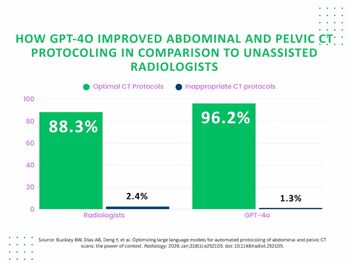Computed Tomography Insights on GI Bleeding: Nine Takeaways from New Consensus Recommendations
In joint consensus recommendations issued from the Society of Abdominal Radiology and the American College of Gastroenterology, researchers discussed key pearls, benefits, and limitations of CT angiography for imaging of overt lower GI bleeding and CT enterography for detecting small bowel bleeding.
Offering a variety of insights on the use of computed tomography angiography (CTA) and computed tomography enterography (CTE) to diagnose overt lower gastrointestinal bleeding (LGIB) and small bowel bleeding, respectively, the Society of Abdominal Radiology and the American College of Gastroenterology have published recommendations to facilitate standard approaches for optimal imaging of these conditions.
Here are a few key takeaways from the consensus recommendations that were recently published in
1. For overt LGIB, the consensus authors emphasized multiphase CT acquisitions, including non-contrast, late arterial and portal venous or late venous phases. Changes in the size and attenuation of the bowel lumen due to an accumulation of contrast material confirms extravasation of contrast-enhanced blood, a key finding for diagnosing acute hemorrhage, according to the consensus authors.
2. The researchers maintained that the portal venous phase, initiated 60 to 70 seconds after intravenous contrast injection, facilitates better detection of slow venous bleeding. Other benefits of this phase include enhanced visualization of the bowel wall and other solid organs.
3. Noting robust sensitivity, specificity, and accuracy rates with computed tomography angiography (CTA) for diagnosing overt GI bleeding, the consensus authors said key advantages of CTA include:
• localization of the hemorrhage site through detection of active contrast material extravasation or intraluminal blood products;
• enhanced diagnosis of subtle GI tract lesions through techniques such as dual-energy acquisition and digital subtraction; and
• vascular and enteric anatomical insights that may facilitate optimal selection and planning for interventional procedures.
4. While a key limitation of multi-phase image acquisition with CTA is increased radiation exposure, the researchers maintained that split contrast bolus acquisition and dual-energy CT can reduce the number of imaging phases with corresponding decreases in radiation dosing.
When Small Bowel Bleeding Is Suspected
5. For suspected small bowel bleeding, the consensus authors said neutral oral contrast agents are preferred in computed tomography enterography (CTE) protocols. These agents improve conspicuity with hyperenhancement of inflammation, vascular lesions and some neoplasms that represent the majority of small bowel abnormalities that lead to GI bleeding, according to the researchers.
6. While multiphasic CTE exams are recommended for diagnosing vascular lesions in the small bowel, the consensus authors noted that a single enteric or portal venous phase is sufficient for diagnosing inflammation and the majority of small bowel masses.
7. The researchers pointed out that one meta-analysis showed pooled sensitivity and specificity rates of 72.4 percent and 75.2 percent, respectively, for detecting the etiology of small bowel bleeding with CTE.
8. In terms of advantages over endoscopic techniques, the consensus authors said key benefits of CTE include:
• enhanced sensitivity for small bowel masses;
• improved visualization of changes in the mesentery, bowel wall and bowel/mesenteric vessels that may contribute to GI bleeding; and
• serving as a first-line imaging option for characterization of occult small bowel bleeding for patients who cannot undergo capsule endoscopy procedures due to contraindications including Chron’s disease, small bowel stenosis or prior surgery.
9. In terms of CTE limitations, the researchers cautioned that use of neutral oral contrast agents may lead to dilution of contrast material extravasation. The consensus authors also pointed out that hyperintense bowel contents and cone-beam artifacts may obscure vascular abnormalities and subtle masses on CTE.
Newsletter
Stay at the forefront of radiology with the Diagnostic Imaging newsletter, delivering the latest news, clinical insights, and imaging advancements for today’s radiologists.





























